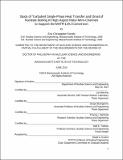Study of turbulent single-phase heat transfer and onset of nucleate boiling in high aspect ratio mini-channels to support the MITR LEU conversion/
Author(s)
Forrest, Eric Christopher
DownloadFull printable version (11.77Mb)
Other Contributors
Massachusetts Institute of Technology. Department of Nuclear Science and Engineering.
Advisor
Lin-Wen Hu, Jacopo Buongiorno, and Thomas J. McKrell.
Terms of use
Metadata
Show full item recordAbstract
Heat transfer in high aspect ratio mini-channels has important applications for materials test reactors using plate-type fuel. These fuel plates typically possess coolant channels with hydraulic diameters on the order of 4 mm or less. The single and two-phase heat transfer in such channels has not been well-characterized, especially in regard to the onset of nucleate boiling. While surface effects are known to dramatically influence the incipience of boiling, they have not been widely considered under forced convection. Since the limiting safety system setting for the MITR is the onset of nucleate boiling, there is considerable interest in better characterizing the phenomenon in such channels. This study presents a first-of-a-kind, two-phase flow facility designed to measure the single-phase heat transfer coefficient and onset of nucleate boiling in a high aspect ratio mini-channel over a wide range of flow conditions while also permitting high speed visualization of the entire surface. The single-phase heat transfer coefficient is measured for mass fluxes ranging from 750 kg/m2-sec up to 6000 kg/m2 -sec and for sub-coolings ranging from 20 °C to 70 °C. The onset of nucleate boiling superheat and heat flux are measured for mass fluxes ranging from 750 kg/m2- sec to 3000 kg/m2-sec and for sub-coolings ranging from 10 °C to 45 °C. Measurements are supported with high speed videography to visualize bubble incipience when conditions permit. The influence of surface wettability on the incipience point is also investigated by performing tests on a surface oxidized at high temperature in air. Using a boundary layer analysis along with experimental data obtained in the study, a semi-analytical correlation is developed to predict the single-phase heat transfer coefficient in high aspect ratio rectangular channels. The correlation accounts for effects from secondary flows and heating asymmetry, and is suitable for both the transition and fully turbulent flow regimes. The new correlation predicts the Nusselt number with a mean absolute error of 4.9% in the range of 2.2<Pr<5.5 and 4000<Re<70,000. The onset of nucleate boiling heat flux on the reference surface is adequately predicted with the correlation of Bergles and Rohsenow, as long as the appropriate single-phase heat transfer prediction is used. However, the oxidized surface displays a modest increase in the incipient heat flux due to the improved wettability. This effect is not captured in the correlation of Bergles and Rohsenow, but is accounted for in other correlations such as that of Davis and Anderson. Surface science measurements are presented for prototypical materials test reactor fuel surfaces to quantify effects of roughness, oxidation, and surface contamination on wettability. Overall, surface cleanliness is found to have a profound effect on wettability, and in turn, is expected to influence boiling incipience.
Description
Thesis: Ph. D., Massachusetts Institute of Technology, Department of Nuclear Science and Engineering, 2014. Cataloged from PDF version of thesis. Includes bibliographical references (pages 409-425).
Date issued
2014Department
Massachusetts Institute of Technology. Department of Nuclear Science and EngineeringPublisher
Massachusetts Institute of Technology
Keywords
Nuclear Science and Engineering.